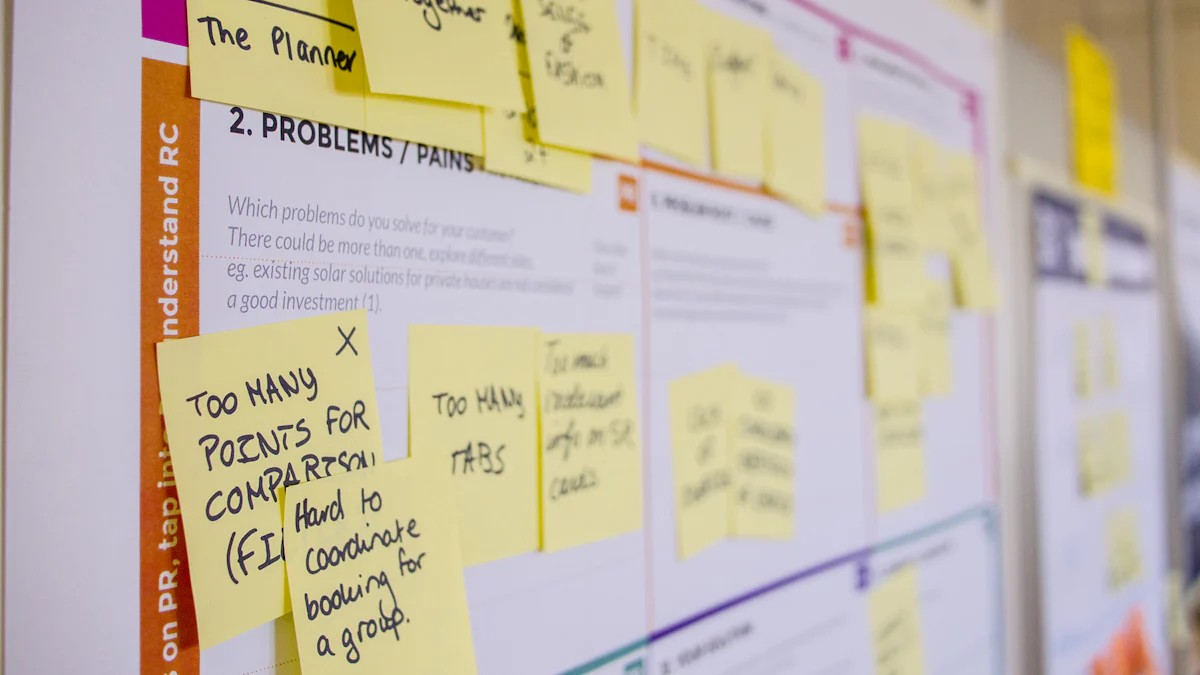Why Lean Software Development Matters for Modern Projects

Lean software development plays a crucial role in modern projects by improving efficiency, adaptability, and customer satisfaction. It eliminates waste, streamlines workflows, and ensures teams focus on delivering value. A 2023 Forrester Research survey revealed that products built with lean methodologies achieved a 20% higher user satisfaction rate. Additionally, Deloitte’s Global Cost Survey found that companies using lean practices reduced development costs by 15-25%. These results highlight how lean empowers you to meet changing demands while maintaining quality. By adopting lean development practices, you can overcome inefficiencies and deliver impactful solutions.
Key Takeaways
Lean software development saves time by removing waste and simplifying tasks.
Using lean methods can cut costs by 15-25% and make users 20% happier.
Tools like Kanban boards and value stream maps help teams see tasks and fix delays.
Letting teams decide builds trust and teamwork, making work faster.
Always improve; get feedback often to make better products for customers.
The Importance of Lean Software Development

Addressing Modern Challenges
Adapting to fast-changing market demands
In today’s fast-paced world, market demands shift rapidly. Lean software development equips you to adapt by focusing on iterative processes. These short cycles allow you to release updates quickly, gather feedback, and refine your product. For example, iterative development cycles enable teams to respond to new customer needs or technological advancements without disrupting workflows. This flexibility ensures your product stays relevant in a competitive landscape.
Meeting customer expectations for quality and speed
Customers expect high-quality software delivered at lightning speed. Lean practices help you balance these priorities by emphasizing efficiency and eliminating waste. A 2023 Stack Overflow survey revealed that 45% of developers struggle with balancing speed and quality. Lean methodologies address this challenge by embedding quality checks throughout the process, ensuring faster delivery without compromising standards.
Tip: Use lean principles to focus on customer-centric features and deliver value faster.
Challenge | Evidence |
|---|---|
Cultural Shift | 60% of organizations cited cultural resistance as the biggest hurdle in implementing lean practices (Harvard Business Review, 2022). |
Balancing Speed and Quality | 45% of developers struggle with balancing speed and quality in lean environments (Stack Overflow, 2023). |
Resistance to Change | 40% of lean transformation initiatives fail due to employee resistance (McKinsey, 2022). |
Measuring Progress | 55% of organizations struggle to define appropriate metrics for lean software development (Gartner, 2023). |
Maintaining Long-term Focus | 30% of organizations abandon lean practices within two years due to a lack of sustained focus (Lean Enterprise Institute, 2022). |
Enhancing Team Efficiency
Reducing waste in processes and workflows
Lean software development focuses on eliminating waste to maximize efficiency. By removing non-value-added activities like excessive meetings or unnecessary documentation, you can streamline workflows. Lean practices also help manage dependencies in large projects, ensuring smoother collaboration across teams. This approach allows you to deliver high-quality solutions faster while maintaining focus on customer value.
Improving collaboration and communication
Effective communication is the backbone of any successful project. Lean development practices foster collaboration by encouraging transparency and shared ownership. Teams using lean methodologies often rely on tools like Kanban boards to visualize workflows and identify bottlenecks. Improved coordination among teams enhances overall efficiency and ensures everyone works toward a common goal.
Note: Strong communication reduces misunderstandings and accelerates decision-making.
Delivering Value to Customers
Prioritizing features that matter most
Lean software development emphasizes delivering customer value by focusing on features that truly matter. A leading e-commerce company used Scrum and SAFe to prioritize customer needs, resulting in higher satisfaction and loyalty. This approach ensures you invest resources in features that align with user expectations, avoiding unnecessary costs.
Ensuring faster delivery of high-quality products
Lean practices enable you to deliver high-quality products faster by adopting agile methodologies. For instance, a healthcare technology provider used value stream mapping to reduce waste and improve product quality. These strategies ensure your customers receive reliable solutions quickly, enhancing their overall experience.
Organization Type | Lean Practices Implemented | Outcome |
|---|---|---|
Global E-commerce Company | Scrum, SAFe | Increased customer satisfaction and loyalty through prioritizing features. |
Large Financial Institution | Scrum, LeSS, DSDM | Reduced time-to-market and improved customer satisfaction. |
Telecommunications Company | Lean UX, Modern Agile | Enhanced customer satisfaction and user engagement through rapid prototyping. |
Healthcare Technology Provider | Scrum, Nexus, value stream mapping | Reduced waste and improved product quality by focusing on customer needs. |
Software Development Company | Scrum at Scale, Kano Model | Improved customer satisfaction and revenue by prioritizing critical needs. |
Core Principles of Lean Software Development
Eliminate Waste
Identifying unnecessary steps in workflows
Lean software development prioritizes eliminating waste to maximize efficiency. Waste can take many forms, such as unnecessary code, unclear requirements, or delays in communication. For example, starting more tasks than your team can complete leads to context-switching and bottlenecks. By identifying these inefficiencies, you can streamline workflows and focus on delivering value.
Description | |
|---|---|
Unnecessary code or functionality | Delays time to customer, slows down feedback loops |
Starting more than can be completed | Adds unnecessary complexity to the system, results in context-switching and handoff delays |
Unclear or constantly changing requirements | Results in rework, frustration, quality issues, lack of focus |
Defects and quality issues | Results in rework, abandoned work, and poor customer satisfaction |
Streamlining processes to focus on value
Streamlining processes ensures your team focuses on what matters most—delivering value to customers. Lean development practices encourage you to remove non-value-added activities, such as excessive documentation or redundant approvals. This approach allows your team to allocate resources effectively and deliver impactful solutions faster.
Tip: Use tools like value stream mapping to visualize workflows and identify areas for improvement.
Build Quality In
Embedding quality checks throughout development
Building quality into every stage of development prevents defects and reduces rework. Lean software development emphasizes proactive quality assurance. For example, creating a dedicated QA team and integrating automated testing ensures consistent quality. Training your team on QA best practices also fosters a culture of accountability.
Support QA teams with clear schedules and defined testing scopes.
Provide training on the importance of quality assurance.
Continuously monitor and refine QA processes.
Preventing defects rather than fixing them later
Fixing defects after deployment wastes time and resources. Lean encourages you to address potential issues early. Embedding quality checks, such as code reviews and automated tests, helps you catch problems before they escalate. This proactive approach saves time and ensures a smoother development process.
Deliver Fast
Shortening development cycles
Lean software development focuses on delivering value quickly. Shorter development cycles allow you to release updates faster and gather feedback sooner. This approach ensures your product stays relevant in a competitive market. For instance, iterative development cycles enable your team to adapt to changing requirements without disrupting workflows.
Using iterative approaches to release quickly
Iterative approaches enhance delivery speed by fostering continuous improvement. Releasing features in small increments allows you to gather real-time feedback and refine your product. This method ensures your software evolves based on user needs, maintaining its value over time.
Note: Agile methodologies, such as Scrum, complement lean principles by promoting iterative development and faster delivery.
Continuous Improvement
Encouraging feedback and learning
Continuous improvement lies at the heart of lean software development. You can achieve this by fostering a culture that values feedback and learning. Regular feedback loops allow your team to identify areas for enhancement and adapt quickly. For example, methodologies like Scrum and Kanban emphasize iterative processes, enabling you to refine your workflows based on real-time insights.
Methodology | Description |
|---|---|
Lean software development | Focuses on delivering maximum value while reducing waste, prioritizing features that deliver value. |
Agile software development | An iterative approach that emphasizes collaboration and rapid feedback to adapt to user needs. |
Scrum | A framework for iterative development with defined goals for each sprint, enhancing team collaboration. |
Kanban | Utilizes a visual workflow management system to limit work in progress and ensure smooth workflows. |
Iterative and incremental development | Breaks projects into smaller pieces, allowing for continuous refinement based on user feedback. |
However, challenges like resistance to change or bottlenecks in production can hinder progress. You can overcome these by creating a culture of continuous improvement and using automation tools to address bottlenecks. Clear communication and tracking progress also ensure better visibility and informed decision-making.
Refining processes for better outcomes
Refining processes is essential for achieving better outcomes in lean software development. By eliminating waste and focusing on value, you can streamline workflows and improve efficiency. For instance, iterative development cycles allow you to test and refine features continuously. This approach ensures your product evolves to meet user needs effectively. Building competency through training programs also equips your team with the skills needed to implement lean principles successfully.
Tip: Encourage your team to embrace a mindset of learning and adaptability to drive continuous improvement.
Respect for People
Empowering teams to make decisions
Respect for people is a cornerstone of lean development practices. Empowering your team to make decisions enhances their sense of purpose and value. When team members feel trusted, they take ownership of their tasks and contribute more effectively. Practices like pair programming and self-organization promote accountability and improve problem-solving. Regular feedback and coaching also help your team develop skills and foster innovation.
Note: Empowered teams are more motivated and productive, leading to better project outcomes.
Fostering a culture of trust and collaboration
A culture of trust and collaboration is vital for lean software development. Open communication and knowledge sharing improve team morale and productivity. Collaboration tools like Kanban boards facilitate transparency and ensure everyone works toward a common goal. Respect and mutual trust also enhance job satisfaction, which drives innovation and competitiveness. By fostering these values, you create an environment where your team thrives and delivers exceptional results.
Callout: Collaboration and trust are not just values—they are essential for achieving long-term success in lean software development.
Tools and Techniques for Lean Development Practices

Kanban Boards
Visualizing workflows to identify bottlenecks
Kanban boards are essential tools in lean software development. They allow you to visualize workflows by displaying each stage of the development process. This clarity helps you track tasks and identify where work accumulates faster than it progresses. For example, if a column on the board shows a pile-up of tasks, it signals a bottleneck. You can address this issue by limiting work in progress or redistributing tasks among team members. Metrics like control charts and cumulative flow diagrams further refine workflows, ensuring smoother operations.
Managing tasks efficiently
Kanban boards also enhance task management by promoting transparency and collaboration. They enable your team to focus on completing tasks rather than starting new ones. This pull-based scheduling system ensures that no one is overwhelmed, improving productivity and quality. By using Kanban boards, you can foster a culture of accountability and streamline your development process.
Value Stream Mapping
Mapping the flow of value in processes
Value stream mapping helps you analyze and improve the flow of value in your processes. It provides a clear picture of how work moves from idea to delivery. This technique allows you to identify inefficiencies, such as delays or redundant steps, and take corrective action. For instance, mapping can reveal areas where cycle time is unnecessarily long, enabling you to optimize workflows.
Identifying areas for optimization
By using value stream mapping, you can pinpoint bottlenecks and defects that hinder progress. This approach not only reduces cycle time but also improves quality. Measuring relevant metrics helps you identify root causes of delays and prevent them from recurring. Ultimately, value stream mapping ensures your processes align with lean principles, delivering maximum value to customers.
Feature Flag Tools
Reducing risk by toggling features on or off in real time
Feature flag tools play a vital role in lean and agile development. They allow you to release new features in small increments by toggling them on or off in real time. This capability reduces risk by enabling you to quickly disable failing features without affecting the entire system.
Accelerating feedback and minimizing waste
Feature flags also accelerate feedback by letting you test features with a subset of users. This real-time data helps you refine features before a full rollout. By focusing only on features that prove valuable, you minimize waste and avoid investing in ideas that might not work.
Supporting continuous improvement through iterative feature releases
Feature flags support continuous improvement by enabling iterative releases. You can refine and optimize features based on user feedback, aligning with lean principles of rapid learning and enhancement. This approach ensures your product evolves to meet customer needs effectively.
FeatBit as the best feature flag tool for lean and agile development
FeatBit stands out as the best feature flag tool for lean and agile development. It offers robust capabilities for toggling features, gathering feedback, and minimizing waste. FeatBit empowers your team to implement lean development practices seamlessly, ensuring faster delivery and higher-quality outcomes.
5S Methodology
Organizing workspaces for efficiency
The 5S methodology helps you create an organized and efficient workspace. It focuses on five principles: Sort, Set in Order, Shine, Standardize, and Sustain. By applying these principles, you can eliminate clutter, streamline workflows, and improve productivity. For example, sorting tools and resources ensures that only essential items remain in your workspace. This reduces time spent searching for materials and allows you to focus on delivering value.
Using the 5S methodology in software development workspaces offers several benefits:
Increased efficiency
Improved safety
Enhanced employee engagement
Reduced waste
Cost savings
Fostering a culture of continuous improvement
Implementing the 5S methodology significantly contributes to elevating product quality within a manufacturing facility. With standardized procedures and organized workspaces, the likelihood of errors decreases, leading to improved quality control and consistency in output.
Maintaining discipline in processes
Maintaining discipline is essential for sustaining the benefits of the 5S methodology. You can achieve this by setting clear standards and regularly evaluating your workspace. For instance, creating a checklist for daily maintenance ensures that your team follows established procedures. This habit fosters a culture of continuous improvement, where everyone takes responsibility for enhancing processes and work environments. Over time, these practices lead to better outcomes and higher-quality products.
Continuous Integration and Deployment (CI/CD)
Automating testing and deployment
Continuous Integration and Deployment (CI/CD) automates testing and deployment, allowing you to focus on coding rather than manual tasks. Automation ensures that every code change undergoes rigorous testing before deployment. This reduces the risk of errors and improves code quality. For example, automated tests can detect bugs early, enabling quick fixes and minimizing disruptions. By integrating CI/CD into your workflow, you can maintain high standards while accelerating development.
Ensuring faster and more reliable releases
CI/CD supports faster and more reliable software releases by enabling smaller, more frequent updates. This approach minimizes deployment risks and ensures that changes are easier to manage. For instance, automated pipelines allow you to push updates multiple times a day, keeping your product relevant in a competitive market. CI/CD also enhances developer productivity by streamlining workflows and reducing bottlenecks. These benefits align with lean principles, helping you deliver value efficiently.
Tip: Use CI/CD to improve code quality and reduce deployment risks, ensuring a smoother development process.
Steps to Implement Lean Practices
Assess Current Processes
Conducting a value stream analysis
To implement lean practices effectively, you need to start by analyzing your current workflows. A value stream analysis helps you map out each step in your process and identify areas that need improvement. Follow these steps to conduct a thorough analysis:
1. Determine areas for improvement by involving team members who work on these processes daily.
2. Identify non-value-added activities that do not contribute to customer value.
3. Engage your team to brainstorm potential solutions and foster collaboration.
4. Implement the improvements and ensure everyone understands the new processes.
5. Monitor the results and make adjustments to refine efficiency.
6. Standardize the optimized processes to maintain consistency.
7. Use a Daily Management System (DMS) to track progress and encourage continuous improvement.
This structured approach ensures you address inefficiencies and create a foundation for lean practices.
Identifying inefficiencies and bottlenecks
After mapping your processes, focus on pinpointing inefficiencies and bottlenecks. Look for delays, redundant steps, or tasks that slow down progress. For example, excessive handoffs between teams often cause delays. Addressing these issues helps you streamline workflows and improve overall productivity.
Tip: Use tools like value stream mapping to visualize inefficiencies and prioritize areas for optimization.
Define Customer Value
Understanding what customers truly need
Defining customer value is essential for lean software development. Start by engaging directly with your users through interviews, focus groups, or usability testing. These sessions help you observe their behavior and uncover hidden needs. Additionally, implement feedback loops using tools like customer surveys or Net Promoter Score (NPS) to refine your understanding of their expectations. This continuous engagement ensures your product aligns with what customers truly need.
Prioritizing features that deliver the most value
Once you understand your customers’ needs, focus on features that provide the highest value. Avoid wasting resources on unnecessary functionalities. For instance, analytics can help you identify which features users engage with the most. Prioritizing these ensures your team delivers impactful solutions efficiently.
Callout: Regularly revisit customer feedback to ensure your product evolves with their changing needs.
Start Small and Iterate
Implementing lean practices in small increments
Starting small allows you to test lean practices without overwhelming your team. Begin with manageable experiments to validate your approach. For example, Dropbox launched a simple video to gauge interest before building their full product. This strategy minimizes risk and provides valuable insights early in the process.
Learning and adapting from each iteration
Iteration is key to success in lean development. Use feedback from your initial experiments to refine your approach. Companies like Zappos tested their market by displaying products online without holding inventory. This iterative process allowed them to adapt quickly and scale effectively. By learning from each cycle, you can continuously improve your workflows and deliver better outcomes.
Note: Rapid iterations based on real-world feedback drive continuous improvement and ensure your product stays relevant.
Foster a Lean Culture
Encouraging team collaboration and ownership
Creating a lean culture begins with fostering collaboration and ownership within your team. Lean principles promote self-organization and autonomy, encouraging team members to take responsibility for their tasks. This approach builds accountability and enhances motivation. When individuals feel empowered, they contribute more effectively to problem-solving and innovation.
To strengthen collaboration, you can implement practices like shared learning platforms and pair programming. These methods prevent knowledge silos and reduce redundant efforts. Improved communication within the team minimizes errors and ensures everyone works toward shared goals. A collaborative environment not only boosts job satisfaction but also drives better outcomes for your projects.
Tip: Empower your team by providing opportunities for decision-making and recognizing their contributions.
Promoting a mindset of continuous improvement
A lean culture thrives on continuous improvement. Encourage your team to view every challenge as an opportunity to learn and grow. Regular feedback sessions and retrospectives help identify areas for enhancement. By fostering a mindset of adaptability, you ensure your team remains agile in the face of changing demands.
You can also support this mindset by celebrating small wins and learning from setbacks. These practices create a positive atmosphere where your team feels motivated to refine processes and deliver greater customer value. Over time, this commitment to improvement becomes a core part of your organizational culture.
Callout: Continuous improvement is not a one-time effort. It is a journey that requires persistence and dedication.
Measure and Optimize
Tracking key performance metrics
Measuring performance is essential for optimizing lean practices. Key metrics provide insights into your team’s efficiency and highlight areas for improvement. Consider tracking the following metrics:
Metric | Description | Formula |
|---|---|---|
Throughput | Measures a machine's production capabilities over a specific period. | Throughput = Units Produced / Time |
Cycle Times | Average time spent producing products, indicating efficiency. | Cycle time = End Time – Start Time |
Overall Equipment Effectiveness (OEE) | Measures the efficiency of manufacturing operations, combining availability, performance, and quality. | OEE = Availability x Performance x Quality |
Manufacturing Costs per Unit | Total cost associated with producing a single product. | Cost Per Unit = Total Cost / Units Produced |
First-pass yield (FPY) | Ability to deliver a product correctly without corrections, indicating quality. | FPY = Quality Units / Total Units Produced |
Scrap Rate | Proportion of products with defects that cannot be sold, indicating inefficiencies. | Scrap Rate = Scrap Units / Total Units |
These metrics help you monitor progress and ensure your team stays aligned with lean principles.
Refining processes based on data and feedback
Data and feedback are powerful tools for process refinement. Use the insights from your performance metrics to identify inefficiencies and implement targeted improvements. For example, if your cycle time is too long, analyze the workflow to pinpoint delays and eliminate unnecessary steps.
Feedback from your team and customers also plays a crucial role. Regularly gather input to understand pain points and opportunities for enhancement. By combining data-driven insights with real-world feedback, you can refine your processes and achieve better outcomes. This iterative approach ensures your team consistently delivers value while adhering to lean principles.
Note: Refining processes based on measurable data ensures your efforts remain focused and effective.
Lean software development transforms how you approach modern projects. It enhances efficiency, adaptability, and customer satisfaction. Teams using lean development practices deliver high-quality software solutions faster while reducing costs by 15-25%, as Deloitte’s 2023 Global Cost Survey shows. Tools like feature flags, such as FeatBit, empower you to minimize risks, gather feedback quickly, and continuously improve. Products built with lean methodologies achieve 20% higher user satisfaction, according to Forrester Research. By adopting this mindset, you can overcome challenges, foster innovation, and stay competitive in today’s fast-paced market.
FAQ
What is lean software development?
Lean software development is a methodology that focuses on delivering maximum value to customers while minimizing waste. It emphasizes efficiency, quality, and adaptability by streamlining processes, prioritizing customer needs, and fostering continuous improvement.
How does lean software development reduce waste?
Lean reduces waste by identifying and eliminating non-value-added activities. Examples include unnecessary documentation, excessive meetings, and unclear requirements. Tools like value stream mapping and Kanban boards help you visualize workflows and pinpoint inefficiencies.
Why are feature flags important in lean development?
Feature flags let you release features incrementally by toggling them on or off. This reduces risk, accelerates feedback, and minimizes waste. Tools like FeatBit enable you to refine features based on real-time user data, supporting continuous improvement.
How do you start implementing lean practices?
Begin by assessing your current processes through value stream analysis. Identify inefficiencies, define customer value, and implement small changes. Use tools like Kanban boards and CI/CD pipelines to streamline workflows and foster a culture of continuous improvement.
What tools support lean software development?
Key tools include Kanban boards for workflow visualization, value stream mapping for process optimization, and feature flag tools like FeatBit for iterative releases. CI/CD pipelines and the 5S methodology also enhance efficiency and quality.
Tip: Choose tools that align with your team’s needs and goals for maximum impact.
See Also
Boosting Agile Product Development With Lean Principles
Enhancing Efficiency In Agile Through Lean Development
Understanding Core Principles Of Lean Agile Development

